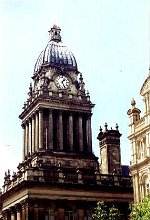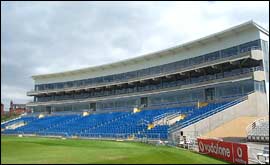Few organists can find themselves amidst
such creative compositional talent as those resident
in the county of broad acres. Among many delights accruing
from making music in Leeds over almost a quarter of
a century has been the chance to experience the first-fruits
of new repertoire for the organ from the pens of distinguished
composers based locally who have become friends as well
as colleagues. Leaving aside the doyen of them, and
us all, the ever-youthful and amazingly prolific Francis
Jackson, chief claim for consideration must be shared
between two men separated by twenty five years but drawn
together by personal friendship and frequent professional
collaboration.
As the century and the present millennium
draw peacefully (or hurtle hectically) to a close, special
birthdays last year and in 1999 have provided a welcome
opportunity for more careful consideration of the output
of two household names in Yorkshire music -
James Brown (75 last year) and Philip Wilby (50
this). Both men are in the public mind linked inextricably
with the vibrant music department at the University
of Leeds - now headed
up by fellow organist Graham Barber, nominated very
recently to a Professorial chair in performance.
It was the writer's great good fortune
to work with Brown and Wilby -
together - in the 1976 Leeds Musical Festival -
then under the directorship of the redoubtable
Professor Alexander Goehr. He it was who decided that
the then traditional recital by the Parish Church Choir
should contain James Brown’s Variations for Organ
and Strings and Philip Wilby, being the musical
polymath that he is, led the professional orchestra
engaged for the occasion.
The catalyst that this event proved
to be has been a life-enhancing benefit for myself,
and certainly for others too. No metaphorical ivory
towers from Brown or Wilby! James has laboured indefatigably
for local music in his adopted city outside the University
precincts, and is a leading light in the thriving Leeds
Music Club and other community groups while Wilby has
often looked further afield, providing Canticles for
John Scott at St Paul’s, a set of Canticles and a Mass
for Norwich and a number of celebratory anthems for
Cathedrals near and far. As someone who tries occasionally
to compose but finds arranging rather more congenial
(and certainly far less time-consuming), the writer
regards the commitment of both men to their respective
creative muses impressive and even awe-inspiring.
Both have produced substantial works
for the king of instruments, several of which it
has been my great good fortune to study and perform.
John Birch had been the hugely persuasive soloist in
1976 for the Brown Variations, and it was the
vivid memory of those which emboldened an approach to
Leeds Organists’ Association to request a commission
from James for 1993 - the
year of the centenary of the granting of the City Charter
by Queen Victoria, who managed to "do" Sheffield
and Leeds on the same February day. (A continuing involvement
with Brown’s output in the intervening years had been
the participation by the Leeds Parish Church Choristers
in his Oratorio The Baptism of Christ for Meredith
Davies and Leeds Philharmonic Society. A tangible product
of that happy collaboration was a short anthem for upper
voices with a text from Tobit -
If ye turn to Him with your whole heart -
published, like much of James’s recent output,
by Banks Music Publications.)
Brown responded handsomely to the invitation,
producing a remarkable set of variations on a theme from Easter
Vespers. Where Elgar had, in his Opus 36, captured the essence
of human character, Brown - in
his Centenary Variations - is
similarly successful with geographical locations. After presenting
the theme - a Paschal Alleluia
from Kirkstall Abbey - in
the tenor in meditative style with shimmering string accompaniment,
the first  variation
portrays the Town Hall and Civic Buildings -
solid, dependable music like the structures themselves.
A Gavotte follows, paying homage to Temple Newsam House on the
eastern perimeter of the city (the Hatfield of the North as
we know it locally); much of this variation is in duo form
for two upper voices, rather in the manner of a French organ mass
of the l8trh century but with the material disposed in a recognisably
contemporary, and English idiom. The treatment on Elland
Road (home of Leeds United) incorporates, ingeniously, the fans’
chant. A more reposeful style is adopted for the "Hospitals
and University" which, between them, provide the inspiration
for Variation Four. The sporting imagery is taken up again in
"Headingley" - a
variation
portrays the Town Hall and Civic Buildings -
solid, dependable music like the structures themselves.
A Gavotte follows, paying homage to Temple Newsam House on the
eastern perimeter of the city (the Hatfield of the North as
we know it locally); much of this variation is in duo form
for two upper voices, rather in the manner of a French organ mass
of the l8trh century but with the material disposed in a recognisably
contemporary, and English idiom. The treatment on Elland
Road (home of Leeds United) incorporates, ingeniously, the fans’
chant. A more reposeful style is adopted for the "Hospitals
and University" which, between them, provide the inspiration
for Variation Four. The sporting imagery is taken up again in
"Headingley" - a kind of free recitative which comes next -
with the music illustrative of the cumulative business
of bowling at the wicket. The most famous of the city's glorious
parks, Roundhay, and its lake are next recalled, and the Parish
Church treatment finds the composer in elegiac mood with reminiscences
of Wesley’s Easter anthem Blessed be the God and Father taking
up again the Easter ambience of the underpinning plainchant on
which the whole is based. And lastly, comes the bustle of the
Market as the finale - an environment
in which JB is often to be found on purposeful perambulation doing
his shopping.
kind of free recitative which comes next -
with the music illustrative of the cumulative business
of bowling at the wicket. The most famous of the city's glorious
parks, Roundhay, and its lake are next recalled, and the Parish
Church treatment finds the composer in elegiac mood with reminiscences
of Wesley’s Easter anthem Blessed be the God and Father taking
up again the Easter ambience of the underpinning plainchant on
which the whole is based. And lastly, comes the bustle of the
Market as the finale - an environment
in which JB is often to be found on purposeful perambulation doing
his shopping.
The Variations comprise the latest work for organ
from Brown, whose pen has been that of the "ready writer"
of psalmody fame for over forty years -
for he was Lecturer in Music and University Organist from
1948 until retirement. Other works from his not inconsiderable
output include wedding presents for friends and pupils, a number
of pieces for English virtuoso Allan Wicks -
a contemporary and colleague of James’s -
The Burning Bush for Gillian Weir and even a voluntary
for his local Anglican parish at Kirkstall. Some works, too, clearly
just written for the fun of it, vie for the attention in his portfolio
with the more straightforward pieces d’occasion not least
of which is the vivid Festal Toccata written for Donald Hunt to
play at the 1961 Leeds Musical Festival and well worth more than
the occasional airing.
If the Centenary Variations stand out
in James’s output in a special and personal way, so
too from Philip do two Triptychs -
Roses for the Queen of Heaven and Prelude,
Fugue and Toccata. Wilby’s music encompasses a very
wide stylistic range - from
melodically straightforward and often hypnotically beautiful
writing for the Anglican liturgy to utterances of a
decidedly more contemporary idiom. Of his vocal output
the carol The Word made flesh (Chester Music)
is a world-beater, his Advent piece for treble voices,
Echo Carol (Banks Music Publications), is a hardy
annual at the St Paul’s Advent Carols and his Motet
for Mother Julian, Vox Dei (Chester Music) has
been anthologised by the RSCM. An ecstatic Prayer
of Manasseh written for the Bishop of Ripon shows
what marvellous sonority can be gained from a choir
singing very slowly and mostly very quietly.
The first Triptych .
Roses for the Queen of Heaven -
is, frankly, of formidable difficulty and exists,
like the famous Reubke Sonata on Psalm 94, in an additional
version for solo piano which Martin Roscoe premiered.
The work is a large-scale concept, yet disposed over
only a moderate timescale in performance terms. Each
piece is based on a medieval rose window, and its special
colours and overall design are integral to the musical
layout. The general colour of each window is reflected
and there are then more detailed descriptions in the
music of individual panes of glass. After Reims West
- the first of
the three movements - is
dedicated to Philip’s friend and former professional
colleague, James Brown. The overall colour of the window
is blue, with heraldic panels. It is dedicated to the
Virgin. The music unfolds from an opening pedal theme
and much organ colour is directed to be deployed during
the music, which is essentially processional in concept.
The tonality is so disposed so that performance can
incorporate the preliminary singing of the Antiphon
to Our Lady, Salve Regina.
The Prelude, Fugue and Toccata, composed
as a gift for the writer, was produced in 1990. Each movement
is prefaced by a scriptural text. The first deals with the Annunciation,
the second with the mystery of the Incarnation (quoting the famous
lines from Isaiah - The people
that walked in darkness) and the brilliant finale again calls
to mind Handel’s Messiah: Et incarnatus est (For unto us
a child is born....)
[ written1999, submitted 2003]
see also James
Brown by David Wright